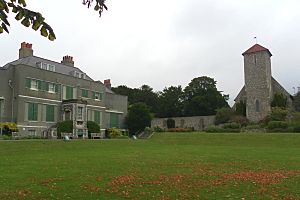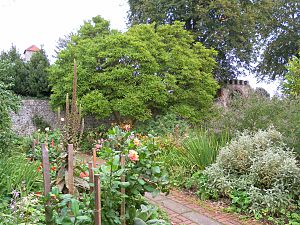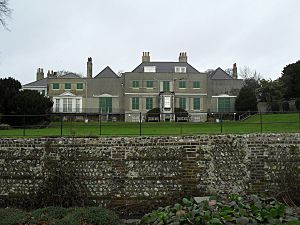Preston Manor, Brighton facts for kids
Quick facts for kids Preston Manor |
|
|---|---|

Main (north) façade of Preston Manor, looking south
|
|
| Location | Preston Drove, Preston Village, Brighton and Hove BN1 6SD, United Kingdom |
| Founded | 13th century |
| Built | 1250 |
| Built for | Lord of the manor of Preston |
| Rebuilt | 1738 |
| Restored | 1905 |
| Restored by | Charles Stanley Peach |
| Architect | Thomas Western |
| Architectural style(s) | Palladian/Georgian |
| Visitors | 8,000 (in 2012) |
| Governing body | Brighton & Hove City Council |
|
Listed Building – Grade II*
|
|
| Official name: Preston Manor and attached railings | |
| Designated | 13 October 1952 |
| Reference no. | 1380750 |
| Lua error in Module:Location_map at line 420: attempt to index field 'wikibase' (a nil value). | |
Preston Manor is an old country house in Preston, a village that is now part of the city of Brighton and Hove, England. The house you see today was mostly built in 1738. It was rebuilt by Thomas Western, who was the Lord of the manor at the time. Some parts of the original 13th-century building are still inside. In 1905, Charles Stanley Peach made more changes, giving the house its current look.
Over the years, Preston Manor had several owners. For a long time, it belonged to the Diocese of Chichester (a church area) and then to the Crown. Later, it was owned by the Stanford family, who were known as one of the richest families in Sussex.
In 1932, the Stanford family gave Preston Manor to Brighton Corporation (now Brighton & Hove City Council). Since then, it has been a museum. It shows what life was like for wealthy families and their servants during the Edwardian era (the early 1900s). The manor also has a historic walled garden with old flint walls, a ruined wellhouse, and even a pet graveyard.
Preston Manor is famous for being one of the most haunted buildings in Britain. Many people have reported seeing ghosts there. It has even been featured on TV shows and has special ghost tours. The house is considered very important for its history and architecture.
Preston Manor reopened to the public in April 2025. It is still like a time capsule from the Edwardian period. Visitors can use a new audio guide that features actors playing the real people who lived there, including the Stanford family and their staff. People who live in Brighton and Hove get a reduced ticket price. An entrance ticket is valid for a whole year, so visitors can return for free. There is also a new cafe open on weekends in the formal dining room. The Brighton and Hove Museums Trust, which owns the manor, also holds special events there.
Contents
History of Preston Manor
Preston village began a very long time ago, probably in the 800s or 900s. Its name, Preste-tun, means "priest's farmstead." This shows it was an important place. By the 1500s, it was often called "Bishops Preston" to avoid confusion with other places named Preston.
In 1086, a big survey called the Domesday Book showed that Preston was an important manor. There would have been a manor house then, likely made of wood, but no parts of it remain. The manor was owned by the Bishop of Chichester. The survey said the manor was worth £25 and had a church, the manor house, and a mill.
The bishops later started renting out their lands instead of farming them directly. In 1510, Edward Elrington and his wife Beatrix Shirley became the first tenants at Preston. Edward died in 1515, and his family continued to live and farm sheep there.
Building the Manor House
The current Preston Manor started as a simple stone building in the mid-1200s. It had two rooms and faced north. Parts of this 1250 house can still be seen in the basement. The walls were very thick, about 2 feet (0.6 meters). The main hall was on the right side, and the second room was on the left. Both rooms had fireplaces.
After the Dissolution of the Monasteries (when the King took control of church lands), the Crown took over the manor. The Elrington family then rented it from the Crown. When Richard Elrington died in 1569 without sons, the manor went to his widow, and then to her son, Anthony Shirley.
Anthony Shirley or his son Thomas made the first big changes to the manor house in the 1600s. They added fancy entrance doors. A part of the staircase, which is mostly from 1738, might also date back to around 1685. The walled garden was also created around this time.


The Western Family Era
In the early 1700s, the Western family took ownership of Preston Manor. Thomas Western, who inherited the manor in 1733, decided to rebuild it. He kept the 13th-century core but gave the house a new look in 1738. He might have designed it himself, as a stone in the basement has his name and the date.
He gave the building a balanced, five-section front in the Palladian and Georgian styles. This style was popular for grand houses. He also added wings on the west and east sides, which looked like smaller buildings. These wings held a dining room and a library.
When Thomas Western died, the manor eventually passed to his sons. One of his sons, Charles, married Frances. Sadly, Charles died in an accident. Frances then moved away from Preston Manor with her children. In 1794, the manor and about 1,000 acres of land were sold to William Stanford for £17,600. This ended the Western family's long connection with Preston.
The Stanford Family Era
William Stanford came from a wealthy farming family. When he bought Preston Manor, it included the house, farm, and surrounding lands. He was already very rich. Around this time, the inside of the house was redecorated in the Adam style.
William Stanford sold his farm produce in Brighton, which was growing fast. He even had a contract to clear sewage from the streets. In 1808, he became the High Sheriff of Sussex. When he died in 1841, he was one of the richest people in the county.
His eldest son, William Stanford the younger, inherited Preston Manor. He continued to live as a wealthy country farmer. His daughter, Ellen, was born in 1848 and later became the heir to the Stanford Estate.
Ellen married Vere Fane Benett-Stanford in 1867. According to her grandfather's will, Vere took the Stanford surname. They had one son, John Montague Benett-Stanford. John later joined the army and became a newsreel photographer.
The Stanford family became very powerful in the 1800s. They bought more land around Brighton and Hove, which allowed them to control how the towns grew. They earned a lot of money from rents and by selling land for building. When railway lines crossed their estate, they received £30,000 as payment.
In 1905, Ellen and her second husband, Charles Thomas, decided to make Preston Manor their main home. Charles Stanley Peach, a friend of the Stanfords, was hired to make big changes to the house and grounds. He added a verandah (a covered porch), a new dining room, and rooms for visitors and servants. He also made changes to the basement and added new attic rooms.
Charles became involved in local politics. In 1910, he was elected Mayor of Brighton and served until 1913. Preston Manor became a place for many important social events. In 1914, Charles became a Member of Parliament. During the First World War, Ellen and Charles helped organize gifts for Indian soldiers and Ellen wrote letters to families who had lost loved ones.
Preston Manor Becomes a Museum
By 1918, Ellen was thinking of selling Preston Manor to Brighton Corporation. In 1925, Charles bought Preston Manor from his wife's trustees. He arranged in his will that after he and Ellen died, the manor and four acres of land would be given to Brighton Corporation. The condition was that it must be kept in its historic condition and used as a museum about Brighton and Sussex.
Sir Charles and Lady Ellen Thomas-Stanford lived at Preston Manor until their deaths in 1932. Charles left his books and historical papers about Sussex to the Corporation. Ellen left the furniture and contents of the house.
The transfer to Brighton Corporation was completed in January 1933. The building then opened to the public as a museum. It showed how a wealthy family and their servants lived in the Edwardian era. During the Second World War, Preston Manor was used as an Air Raid Precaution center. In 1945, Princess Elizabeth (who later became Queen Elizabeth II) visited the manor for tea.
The Victorian servants' quarters in the basement were restored and opened to the public in 1988. The walled garden was also restored in the 1990s. Today, Preston Manor shows visitors what life was like for a rich family and their staff before and after the First World War.
Architecture of Preston Manor
Preston Manor is a two-story building with a balanced Palladian and Georgian style. It is covered in stucco (a type of plaster) and has a roof made of Welsh slates. This design was very popular in the mid-1700s.
The house also has a basement, where you can still see parts of the medieval manor house. There are also attic rooms with dormer windows (windows that stick out from the roof). The main entrance is on the north side.
The entrance has a Classical-style porch with Doric columns. This porch was remodeled in 1905 but dates back to around 1800. On either side of the porch are glass-enclosed verandahs with copper roofs, added in the early 1900s.
The back of the house, facing the garden, also has a central porch made of flint and stone. It has arched windows and a carving of a coat-of-arms. The windows on the main part of the house are similar to the front. The side wings have arched French windows and balconies.
Visitors can explore four levels of the house. This includes the entrance hall, a former library (now the Macquoid Room), and various living rooms. There is a large staircase leading to the first floor, where you can see former bedrooms and an Edwardian bathroom. In the attic, there is a former maids' workroom, now set up as a nursery, and storage rooms. The restored Victorian servants' quarters are in the basement.
Gardens and Other Structures
The 18th-century walled garden is located between the manor house and St Peter's Church. Its flint walls are still from that time. A wooden bridge leads to the garden. The garden is designed to follow the natural slope of the land. It has four connected areas: the walled section, a formal lawn, a sensory garden for blind people, and an area with lily ponds.
A unique feature of the garden is a pet cemetery. It is believed to be the only one in Sussex. Four cats and 16 dogs are buried there in the southwest corner of the garden. The entire grounds of the manor are recognized as a Garden of Historic Interest.
The 18th-century flint walls around the garden are about 280 feet (85 meters) long. They are considered a Grade II-listed structure. When the manor house was rebuilt in 1738, an old arched doorway from the 1500s was moved from the house and placed in the south-facing garden wall.
East of the manor house is a wellhouse, also a Grade II-listed building, dating from the 1730s. It is now in poor condition and has lost its original iron pump. The wellhouse is mostly made of flint with some red brick.
Haunted Reputation
Preston Manor is well-known for its many ghost stories. It is often called one of Britain's most haunted houses. People have reported seeing various ghosts since the 1800s. These include a woman in grey, a blonde woman who was said to be an excommunicated nun, a floating hand, and even a phantom riding a toy tractor.
The blonde nun, often called "The White Lady," is the most famous ghost. Stories about her began in the 1500s, and she was seen most often in the late 1800s. Her last reported sighting was in 1903. One of Ellen Stanford's daughters claimed to have seen her in 1896. A friend of the Stanford family also reported seeing her and learned (supposedly from the ghost) that she was a nun who had been excommunicated and buried on unconsecrated land.
In 1896, during building work behind the house, the skeleton of a middle-aged woman was found. Doctors said the remains were from the 1500s. The Stanford family secretly buried the skeleton in the churchyard. After this, people believed the spirits were at peace, and only two more sightings of a blonde spirit were reported in 1903. White-clad female spirits were also reported in the manor grounds in 1976 and 1992.
Other strange things have been reported at the manor. The same daughter who saw the White Lady also claimed to see two phantom men fighting on another staircase. In the early 1900s, she also felt an "immensely evil" presence in a bedroom. In that same room, visitors reported seeing a floating hand that attached itself to a four-poster bed. Strange noises, moving objects, and doors opening and closing were also reported in this part of the house.
A female ghost dressed in grey has been seen several times throughout the 1900s. Sightings include one in the boiler room and two by a World War II firewatcher. A security guard also reported seeing a ghost in old-fashioned black clothing. In the 1960s, a ghost riding a toy tractor was reported in the grounds.
Because of its many ghost stories, Preston Manor offers regular "ghost tours." The TV show Most Haunted even filmed an episode there in June 2006.
Preston Manor Today
Preston Manor is a very important historical building. It was given a Grade II* listing on October 13, 1952. This means it is considered "particularly important" and has "more than special interest." The garden walls and the ruined wellhouse are also listed at the lower Grade II.
Preston Manor is part of the Preston Village Conservation Area. This area is protected to preserve its historic character. The manor house and the nearby St Peter's Church are the most important buildings in this area.
Brighton & Hove City Council owns Preston Manor. It is managed by the Royal Pavilion and Museums Trust, which also looks after other museums in the city. The manor is run as a museum that shows what life was like during the Edwardian era for the wealthy Stanford family and their servants.
See also
- Grade II* listed buildings in Brighton and Hove




